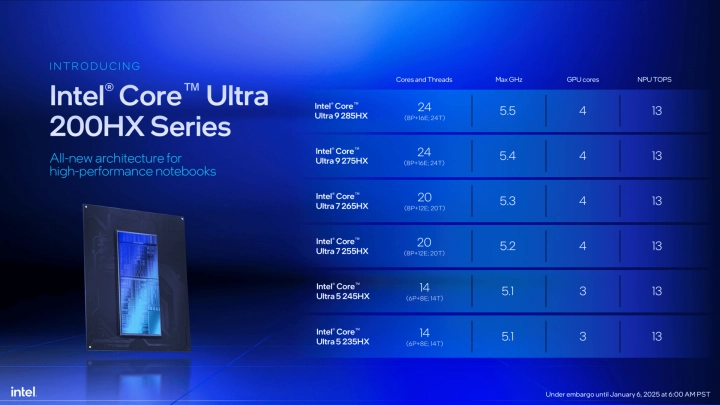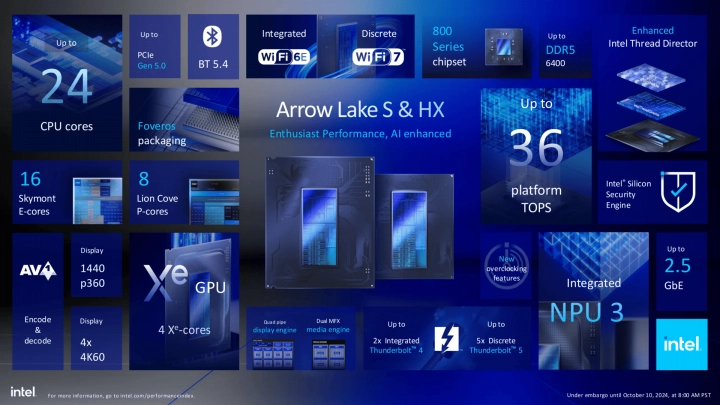Over the week we’ve had various news from CES 2025, but we still haven’t tried them yet. At the trade show in Las Vegas, Intel introduced the first models of this Core Ultra series for notebooks in addition to the desktop 65W and 35W Arrow Lake processors. These processors will complement the already sold Core Ultra 200V “Lunar Lake” with other models that will be less economical, but will provide better performance. For example, gaming laptops will be built on these Arrow Lake processors.
Core Ultra 200HX
The most powerful Arrow Lake series for laptops will be the Core Ultra 200HX (Arrow Lake-HX) models. They are basically the same silicon used by the desktop processors that came out in the fall, but converted to mobile form (so they don’t use an LGA 1851 socket, but a BGA case soldered to the board). These processors will now be Intel’s most powerful notebook solution, replacing the current 14th generation Core HX series.
Core Ultra 200HX processors have 24 cores in their full configuration – eight P-Core cores with Lion Cove architecture and 16 E-Core cores with Skymont architecture with 36 MB L3 cache. These are in a 3nm chiplet manufactured by TSMC. For this, the processor has integrated graphics with 512 shaders (4 Xe Core) of the Xe LPG architecture (as in Meteor Lake), an NPU with 13 TOPS performance and the same multimedia engine as desktop processors. We discussed the features of the Arrow Lake-S desktop processors on which the Arrow Lake-HX is based in more detail here:
Connectivity includes a PCIe 5.0 controller, integrated Thunderbolt 4 support in the processor, DisplayPort 2.1 UHBR20 for up to 8K monitors, and DDR5-6400 memory support. LPDDR5X or other mobile-type memories are not supported by these processors, and the processor also – like the desktop version – still needs an additional 800-series chipset (with additional connectivity, including PCIe 4.0 lanes).
Mobile models with up to 160W consumption limit
The labeling corresponds to this derivation of processors from the desktop. The most powerful processor is called Core Ultra 9 285HX and has those 8+16 cores / 24 threads. The frequency is slightly lower than in the desktop 125W model 285K. The base clock of the P-Core is 2.8 GHz and the maximum boost 5,5 GHz (that’s minus 200 MHz against the 285K model in the desktop). The clock speed of the E-Core cores is 2.1-4.6 GHz.
Arrow Lake-HX processors have a base TDP 55 W and the lowest possible adjustable TDP is 45 W. However, if more cores are loaded, the consumption can soar much higher, the so-called the PL2 limit, or maximum turbo consumption, is the same for the 285HX model 160 W. Which, by the way, is not too far from the maximum turbo consumption of desktop processors of the 65W class (Core Ultra 9 285 has a maximum turbo consumption of 182W, but it is still quite decent against the 250W consumption of the “125W” enthusiast model 285K).
However, it must be said that these highest values will probably not be reached permanently for notebooks, and the constant consumption will stabilize at a lower level during long-term load after cooling saturation. Where, it will be envy of a particular laptop. Performance will also be very individual. You can see some official benchmarks from Intel in the title gallery, but as always, they should be taken with a grain of salt. For example, Intel tests against processors from a slightly lower consumption category (Ryzeny AI 300, Snapdragon X Elite), so the performance comparison may not be completely fair.
In addition to this top model, Intel is also available Core Ultra 9 275HXwhich is a slightly weaker and cheaper Core Ultra 9 (there is no desktop equivalent). This processor has kept the same number of cores and 55-160W consumption. It differs in the one step reduced clock rate of the big cores, which is 2.7 GHz in the base and up to 5.4 GHz in the boost. The E-Core cores are clocked unchanged at 2.1-4.6 GHz.
Next comes the model Core Ultra 7 265HXwhich is already similar to the desktop model 265K. This means 8 P-Core cores (2.3-5.3 GHz clock) and 12 E-Core cores (2.3-4.6 GHz), for a total of 20 threads. L3 cache is reduced to 30 MB. The TDP is again 55 W, with a maximum turbo consumption of 160 W.
Intel offers an alternative model here as well Core Ultra 7 255HXwhich has the same cores, but the P-Core clock is reduced to 2.4-5.2 GHz, and this time the E-Cores are also slightly slower (1.8-4.5 GHz). But the consumption of 55-160 W remains.
And finally, we have two Core Ultra 5 models on offer, both with 6 P-Core cores and 8 E-Core cores. Both also have 24MB L3 cache and trimmed down integrated graphics to just 384 shaders (3 Xe Core). First Core Ultra 5 245HX it has clocks for large cores of 3.1-5.1 GHz and for small ones of 2.6-4.5 GHz. The second model Core Ultra 5 235HX is almost the same, only the P-Core has a lower base clock (2.9-5.1 GHz), while the E-Core is reported to be the same (2.6-4.5 GHz). Incidentally, these models also consume 55-160 W.
vPro and non-vPro models
The real difference between these models is elsewhere. Those “dumbs” (not only the 235HX, but also the 255HX and 275HX) do not have the extended management and security functions that belong to the corporate vPro equipment – they are only in the 245HX, 265HX and 285HX models, so Intel used the opportunity for product segmentation in this .
Even-numbered models will therefore be mainly used in workstations, but odd-numbered models should be enough for gaming computers without any problems (except for the “vPro” 285HX, which will probably be installed in gaming laptops due to the prestige of the top model with the highest clock speed). Technologies that are hereby limited to even-numbered “vPro models” are Intel Active Management Technology, Remote Platform Erase, One-Click Recovery, Total Memory Encryption, SIPP, and Virtualization Technology with Redirection Protection (VT-rp).
On the market in the coming months
Notebooks with Core Ultra 200HX processors are due out this quarter (Q1 2025). As already mentioned, these processors are mainly intended for the most powerful mobile workstations, and then also for gaming laptops, which somewhat overlap with them (in terms of performance, so they are often bought as a cheaper replacement for a “work laptop”). But it doesn’t have to be just laptops. Chinese companies have started to base mini-ITX boards and compact computers on these processors, so Arrow Lake-HX could eventually appear in this market as well.
Resources: Intel, ComputerBase
Source: www.cnews.cz




